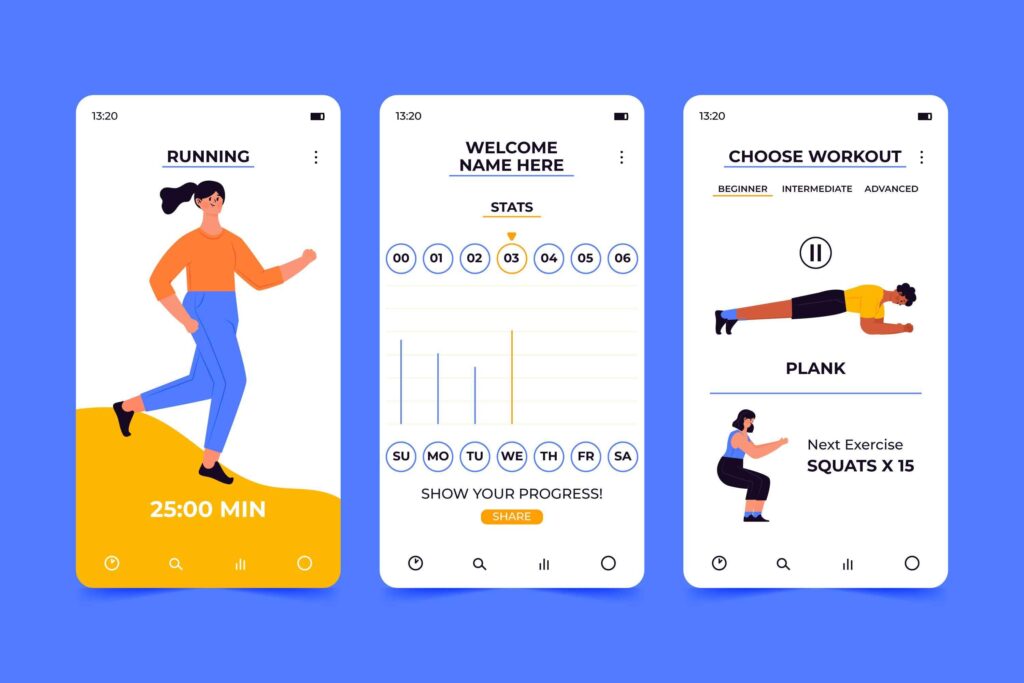The importance of maintaining a healthy lifestyle has become increasingly evident, as people have become more aware of the negative consequences of neglecting their health. With technological advancements, fitness apps have emerged as a popular tool for individuals seeking to achieve their fitness goals with ease and convenience. However, creating a fitness app that resonates with users requires more than just a good idea. Developers must carefully plan the features and functionalities of their app, while also ensuring that they understand the needs of their target audience. In addition, to make a successful fitness app, it’s essential to incorporate innovative features that differentiate it from other apps in the market. Therefore, developers must invest time and effort into researching user needs and building an app that truly speaks to their target audience.
Introduction to Fitness Apps
Fitness apps have revolutionized the way people approach their health and wellness routines. In the USA, where the fitness industry is booming, these apps play a significant role in helping individuals stay motivated, track their progress, and achieve their fitness goals. Whether it’s losing weight, building muscle, or improving overall health, fitness apps offer a wide range of features and functionalities to cater to diverse user needs.
Understanding User Needs
Before diving into the development process, it’s crucial to conduct thorough market research to understand the preferences and requirements of the target audience. This involves identifying demographics such as age, gender, fitness level, and lifestyle habits. By gaining insights into user behavior and expectations, developers can tailor their apps to meet specific needs effectively.
Key Features of Successful Fitness Apps
Successful fitness apps share common features that enhance user experience and engagement. Personalized workout plans, progress tracking, integration with wearables, and social features for motivation are among the essential functionalities. By offering a comprehensive suite of tools, users can customize their fitness journey and stay committed to their goals.
User Interface and Experience (UI/UX) Design
The design of a fitness app plays a crucial role in its usability and appeal to users. A clean and intuitive user interface, coupled with seamless navigation and customization options, ensures a positive experience for users of all skill levels. Accessibility considerations, such as text size and color contrast, are also essential to accommodate diverse user needs.
Developing a User-Centric Approach
Creating a fitness app that truly resonates with users requires ongoing feedback and iteration. By actively soliciting user input and incorporating it into the development process, developers can ensure that their app evolves to meet changing needs and preferences. Continuous improvement based on user feedback is key to maintaining relevance and competitiveness in the market.
Importance of Data Privacy and Security
With the proliferation of personal data collected by fitness apps, ensuring the privacy and security of user information is paramount. Developers must implement robust measures to protect sensitive data from unauthorized access or misuse. Compliance with regulations such as GDPR and HIPAA further reinforces trust and credibility among users.
Monetization Strategies
While offering valuable features and functionalities, developers must also consider monetization strategies to sustain their app’s growth and profitability. Freemium models, subscription plans, and in-app purchases are common approaches to generating revenue. Additionally, strategic partnerships with fitness brands and advertisers can create additional revenue streams.
Marketing and Promotion
Building brand awareness and attracting users to the app requires effective marketing and promotion strategies. Leveraging social media platforms, collaborating with fitness influencers, and offering incentives for referrals can help expand the app’s user base. Creating compelling content and engaging with the community fosters a sense of belonging and loyalty among users.
Case Studies of Successful Fitness Apps
Examining case studies of successful fitness apps provides valuable insights into effective strategies and best practices. By analyzing their approaches to user engagement, feature development, and marketing tactics, developers can glean valuable lessons for their projects. Examples such as MyFitnessPal, Strava, and Nike Training Club showcase innovative solutions to common challenges in the fitness app landscape.
Challenges and Potential Pitfalls
Despite the opportunities in the fitness app market, developers must navigate various challenges and potential pitfalls. Technical issues, fierce competition, and evolving user preferences require agility and adaptability. By staying informed of industry trends and anticipating potential obstacles, developers can mitigate risks and position their apps for long-term success.
Future Trends in Fitness App Development
Looking ahead, the future of fitness app development holds exciting possibilities. Integrating artificial intelligence and machine learning algorithms can personalize recommendations and insights for users. Virtual reality and immersive experiences offer new avenues for engaging workouts and experiences. Furthermore, closer integration with healthcare systems and professionals can bridge the gap between fitness and overall wellness.
Conclusion
Creating a fitness app that resonates with users in the USA requires a thoughtful approach that prioritizes user needs and preferences. By incorporating personalized features, intuitive design, and robust data privacy measures, developers can create an app that empowers users to achieve their health and wellness goals effectively.
FAQs
1. What should I consider when designing a fitness app?
- Focus on user experience, personalization, and data security.
2. How can I monetize my fitness app?
- Explore freemium models, subscription plans, and partnerships with fitness brands.
3. Are there any regulations I need to comply with when developing a fitness app?
- Yes, regulations such as GDPR and HIPAA govern data privacy and security.
4. How can I differentiate my fitness app from competitors?
- Offer unique features, personalized experiences, and exceptional customer support.
5. What trends are shaping the future of fitness app development?
- Trends include AI integration, virtual reality workouts, and closer ties to healthcare systems.



